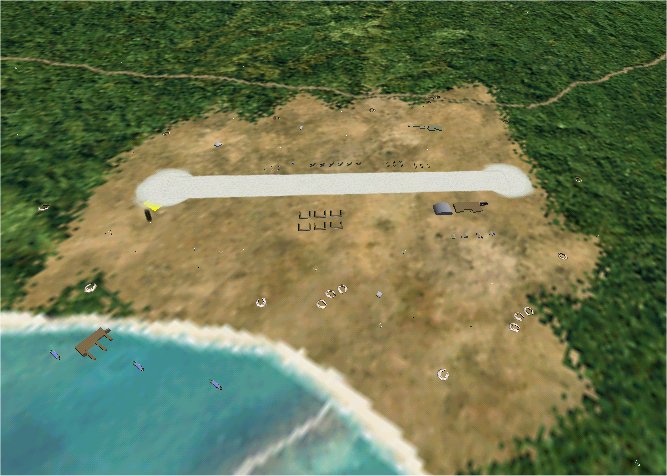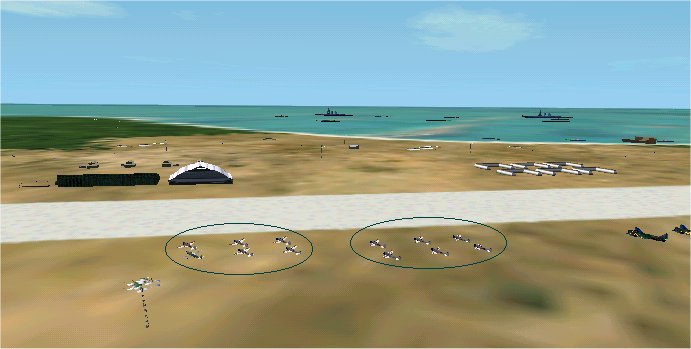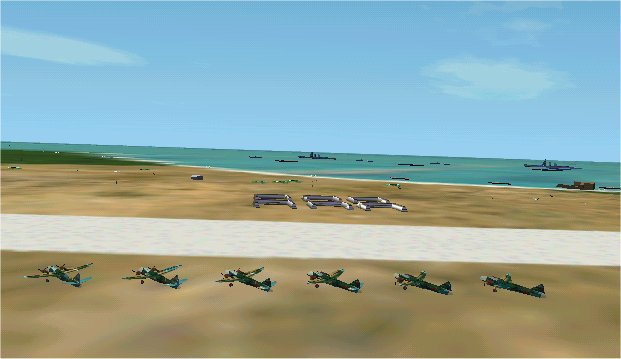



The history of the 2nd Chutai, 68th Sentai, Imperial Japanese Army Air Force, Combat Flight Simulator 2, Pacific Theatre.

History of the 68th Sentai, note: this has nothing to do with the DAI 68th Sentai, which is a Fighter Group on it's own.
Established in 3/1942, at Harbin, Manchuria,
later to be transferred to Rabaul (New Britain), then to New Guinea and Halmahera.
Unit was wiped out by USAAF and disbanded on 07/25/44, in New Guinea and remaining
groundcrew and pilot's where forced to serve as infantry till the end of the
war.
You can click
here to see an overview of the Command Structure
of the IJAAF.This is at the end of the war.So things could be changed at that
time and there is little information about that on the internet.Any corrections
can be e-mailed to : PACCOM.
Known aircraft of the 68th Sentai are:
Nakajima Ki.27 and the Nakajima Ki.61
Known airfields of the 68th:
Kagamihara Airfield, Japan. Madang Airfield near Wewak.
The 2nd Chutai at Wewak Airfield.

Map of New Guinea.
The 2nd Chutai , 68th Sentai , Combat Flight Simulator 2 virtual wing of the Imperial Japanese Army Air Force, was officially formed on the 1st of July, 2002.Founder of the 2nd is 2ndIJA Skies.The squadron was formed as a result of getting too much pilot's in the 6th Kokutai ,which gave a problem on their Command structure.The 6th Kokutai had to make too much Shotai's to get pilot's on the roster, therefor the 2nd Chutai was established.
Until the Royal Air Force captured a Nakajima Ki-43 Hayabusa virtually intact in the spring of 1942, Allied pilots knew little about the planes they were meeting in the air, and even less about the Japanese Army Air Force units opposing them. The situation has improved very little over the years. JAAF records of the air war in the Pacific are necessarily sketchy, since some units -- including the 77th fighter sentai that bore the brunt of combat against the AVG -- were destroyed during the terrible retreats of 1944 and 1945. (Curiously, the records of the 77th were among the few that survived the war.)

Wewak Airfield, Home of the 2nd Chutai 68th Sentai, Imperial Japanese Air Force.
The basic Japanese air combat unit was the sentai,
equivalent to an American or British group, though with only half the aircraft.
With an effective strength of between 30 and 40 aircraft, the sentai was commanded
by a major or lieutenant colonel who was himself a flying officer. The sentai
in turn was divided into three chutai, or squadrons,
usually commanded by a captain. Occasionally a chutai might be detached for
service in an isolated area, or an "independent chutai"
would operate on a continuing basis outside the usual command structure. (An
independent chutai was a bit like a Royal Air Force squadron, which could
move from place to place with its own headquarters staff, attaching itself
to whatever group or wing was already there.)
Moving up the chain of command, two or more sentais -- often a fighter group,
a heavy-bomber group, and a light-bomber or ground-support group -- made up
a hikodan, equivalent to a British wing and usually commanded by a colonel.
Two or more hikodans made up a hikoshidan, equivalent to a geographical air
force and commanded by a general officer.

6th Kokutai's visit for saké.
At the outbreak of the Pacific War, the JAAF consisted of five hikoshidans
with a total of about 1,500 aircraft. One of these was assigned to home defense,
another to Manchuria, and a third to China, leaving two to go on the offensive
in the South Pacific. The 5th Hikoshidan took part in the invasion of the
Philippines, its heavy bombers flying from Taiwan to hit targets in northern
Luzon, while its fighters and light bombers operated from airfields seized
in the opening days of the war. When U.S. and Filipino forces were driven
back upon the Bataan Peninsula, most of the 5th Hikoshidan returned to Taiwan
for reassignment.
Meanwhile, the 3rd Hikoshidan operated against British Commonwealth forces
in Malaya, along with three sentais detached from the 5th. They were based
in French Indochina until fighting began, afterward moving to bases seized
in Thailand and Malaya. That no warplanes appeared over Rangoon until December
23 was a tribute to the resistance put up by Commonwealth air forces in Malaya:
only after the situation was well in hand there did General Michio Sugawara
make his first move against Burma.
By mid-January, with Malaya likewise under control, the 3rd Hikoshidan had
shifted its attention to the Dutch Indies. Meanwhile, the 5th Hikoshidan under
General Eiryo Obata moved into Thailand, rejoined its three detached sentais,
and mounted the major air campaign against Burma.

Betty's on the flightline..............
There is not too much information on the internet regarding the 2nd Chutai's history.I f anyone has some information, please send an e-mail to:PACCOM Webmaster .
Salute to you all..........S~!